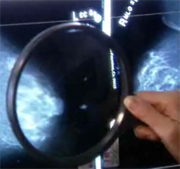
THURSDAY, April 28 (HealthDay News) — A small study of women with breast cancer suggests that those who have previously undergone surgery to receive breast implants face no poorer prognosis than do those without implants, despite the fact that mammograms were less accurate at picking up abnormalities in this group of women.
Women who had had breast implants were more likely to have tumors that could be detected by touch alone and were also more likely to have breast cancer that had spread to the lymph nodes, but the survival rates among both groups in the study were similar, researchers found.
“We found that the women in the augmented group had more palpable tumors and were more likely to have lymph node-positive disease,” said study author Dr. Jessica A. Rayhanabad, a fellow in the breast surgery division at USC’s Keck School of Medicine in Los Angeles. “However, these findings did not translate to a significant difference in survival rates between the two groups.”
But the researchers acknowledged that their small sample size may have skewed survival rates. Women whose cancer has spread to the lymph nodes generally have a poorer prognosis for survival, they noted, since the tumor cells are then able to circulate through the bloodstream to other tissues and sites throughout the body.
The study, by researchers at the University of Southern California, is scheduled to be presented Friday at the American Society of Breast Surgeons’ annual meeting in Washington D.C. Because of its size and because it has not yet been published in a peer-reviewed journal, the findings should be considered preliminary.
“It’s commonly believed that [a breast implant] interferes with our ability to diagnose breast cancer and that augmented women therefore have a worse prognosis should they develop breast cancer,” the authors wrote.
For the study, the researchers reviewed the records of 5,005 women who had been treated for breast cancer over the past 15 years to determine whether the patients with breast implants were diagnosed more advanced disease and therefore had a poorer prognosis. (In medical language, the term for breast implant is “augmentation mammoplasty.”)
In the study, a total of 195 women had previously undergone breast augmentation, and 121 had had a mammogram prior to their diagnosis. The test failed to reveal an existing abnormality in 36 percent of these cases, compared with a false-negative rate of 15 percent in the general population.
However, the researchers found no difference in tumor size, recurrence rate or survival rates between the two groups.
Another breast surgeon not involved in the research said the study’s 15-year time frame was an important limitation, since it suggests that the majority of the patients probably did not undergo digital mammograms, which have become much more widely used in the past three or four years.
“Digital X-rays have really made a big difference in terms of accuracy, because they can penetrate right through everything,” said Dr. Alexander J. Swistel, chief of breast surgery at New York-Presbyterian Hospital/Weill Cornell Medical Center in New York City.
The researchers also noted that MRI can be an important tool for patients with implants, but Rayhanabad cautioned: “I would avoid making general recommendations for screening MRI on all women who have had breast augmentation. It really depends on our ability to assess the breast on mammogram. Obtaining a screening MRI in an augmented women should be at the discretion of the breast imager and surgeon.”
According to the American Society of Plastic Surgeons, roughly 296,000 women underwent breast augmentation surgery last year, which is a 39 percent increase from the year 2000.
“There’s a comfort level surrounding implants that I’ve never seen before, and it’s among women of all ages,” noted Swistel. “We’re now seeing young women who are getting implants as high school graduation presents.”
That degree of comfort may be unfounded, since the researchers noted that the study did not rule out the possibility of poorer outcomes among women with breast implants who develop breast cancer.
“One of the limitations of our study is the small sample size of augmented women,” said Rayhanabad. “We know that lymph node-positive patients, overall, are more likely to have poorer survival. And so it may be that the sample size may be contributing to the lack of difference in survival between the two groups.”
More information
For more about breast cancer survival rates by stage, visit the American Cancer Society.

